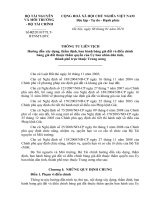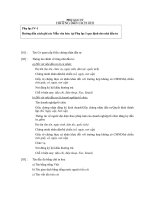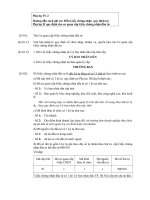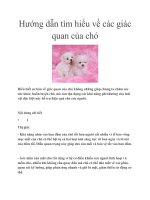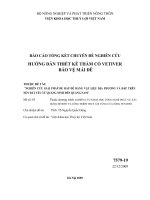Hướng dẫn khâu tay thảm lục giác
Bạn đang xem bản rút gọn của tài liệu. Xem và tải ngay bản đầy đủ của tài liệu tại đây (1.76 MB, 31 trang )
hand sewing hexagons tutorial! {part 1}
{as promised}
Below are step by step directions with photos of how to baste fabric around a hexagon
template. This tutorial will continue in part #2 with attaching the hexagons together. Part
#3 will provide info on removing the plastic quilt patis and one finishing option.
{Directions are written for right handed people... if you sew left handed you'll have to
reverse a a few steps.}
Supplies.
1. Quilt Patis Hexagon Templates or paper templates {I use 1" ones here}
2. Fabric scraps
3. Thread {I use Aurifil}
4. Hand sewing needle
5. Scissors
6. Thin straight pins
7. Accuquilt Go! Cutter {optional}
my go to needles for almost everything
A few notes about Hexagon Templates
1. Most people use paper templates. These can be purchased or made on your own.
While making them on your own seems like a great money saver.. they can be found
very inexpensively and it takes a good amount of time to cut them yourself... especially
accurately.
Where to buy?
Natalie has the giant 3" ones in her shop
Kerri has a variety of sizes in her shop
2. You will see in the photos below that I use Quilt Patis Hexagon Templates. I prefer
the plastic ones for a few reasons. They are stiffer and hold fabric around hexagon shape
very well.
3. You can use both together! {See photo above}
4. If you are using my tutorial below with paper templates... I suggest to punch a hole in
the middle to follow along.
5. Last thing... you'll see below that I baste my hexagons on the back and not through the
template. I always do it this way with the plastic ones... and usually do it this way with
the smaller sizes of paper ones. In the photo below I was working with 3" paper
templates and I based through the paper.
fabrics are...
Urban Zoologie by Ann Kelle {available now}
Urban Circus by Laurie Wisbrun {available in august}
both from robert kaufman
Cutting
Use your accuquilt go! to cut out hexagons in the size needed for your project. For this I
cut the medium size hexagons and used 1" templates. {Note that 1" refers to the size of
one side of the hexagon, not the widest part.}
Here is a photo to show you how big the hexagons are before basting around the plastic
and after.
{ If you don't have an accuquilt go! you can use your templates as a guide to cut your
fabric. }
Basting
Basting is defined as loose stitches that are temporary to hold fabric in place. Usually
this refers to the sandwich of fabric-batting-fabric when preparing to quilt a
quilt sandwich. In this case when I say "Basting" I'm referring to the temporary stitches
used to hold fabric around a hexagon template. {Don't make your stitches "loose" for this
project}
1. Use a straight pin to grab just a few threads of fabric and hold the plastic template in
place. Thread your hand sewing needle with no more than 18" of thread.
2. Start with one side and finger press the fabric over the plastic template.
3. Fold over the next side and use your left thump to hold in place.
4. Use your threaded needle to take a small stitch through both folded sides at the corner
without being too close to the actual corner. Take a second stitch in the same place.
5. Turning counterclockwise fold over the next side.
6. Repeat step #4
7. Continue to repeat the process of folding sides down and basting at the corners all the
way around the hexagon.
8. Remove the straight pin once four corners are based. Sew the last two corners. You
can do a simple knot at the last corner or take a few extra stitches. Both will hold the
basting stitches in place for a while!
In part 2 I'll show you how to sew them together!
happy stitching!!
-want to link to this tutorial?
grab a button!
{144 x 144}
{250x250}
enjoy!!
hand sewing hexagons tutorial! {part 2}
{see part 1 for info on templates & basting}
{see part 3 for info on removing the plastic quilt patis and one finishing option}
-personal note...
I meant to have this done & posted hours ago.. but I discovered and I'm addicted. Between last night and this morning I've spent 10+ hours on the
site and digging through books and papers in the house. I traced one part of my family 11 generations up from me back to 1614!!
-Below are step by step directions for sewing hexagons together. This tutorial will continue in step #3 with finishing directions.
{Directions are written for right handed people... if you sew left handed you'll have to reverse a a few steps.}
fabrics used in most tutorial photos are...
Mon Sheri by Khristian A. Howell {available in october}
from robert kaufman
1. After following the directions in part 1 you'll have a pile of hexagons.
2. You can sew them together to make a flower... or in a random arrangement. The process for attaching them is the same. Start by threading your hand sewing needle with no
more than 18" of thread.
3. Select with two hexagons.
4. Pick them up...
5. Fold one on top of the other along the side you want to sew together.
6. Until they are like this...
7. Turn the two hexagons so that the side you want to sew together is facing up.
8. Take your threaded needle in your right hand.
9. Begin sewing at the right corner and take very small stitches {or bites} out of the fabric.
10. Continue moving right to left along the seam.
11. At the end of the seam take an extra stitch to secure the seam.
12. This will be your result.
13. Choose the next hexagon to attach. I suggest choosing one that can be attached to a seam where your thread is already attached to the pieces you just put together.
14. Just like in step 9 take small stitches and begin to sew this seam.
15. When you reach the end, like in step 11, take an extra stitch to secure the seam.
16. This is the result. Instead of sewing the open seam at the top I suggest again choosing to add another hexagon where your thread is already attached to the pieces you just
put together. {This is personal preference... no single way is right or wrong.}
17. The next hexagon to add.
18. Folded onto of the unit.
19. Beginning to sew it in place. {Again like step 9}
{another angle}
20. Eventually you'll come to a point where your thread is not in a location where you need to add another piece. You could tie a knot and start over, but if you still have a good
amount of thread left there is another option. Place your needle into the seam allowance near the corner your thread is at and take one long running stitch to the closest
intersection that has an open seam.
21. Pull the needle out at that intersection.
22. Think of the hexagon intersections as a Y shape. The first two seams are easier as you can put the hexagons together back to back. {See step 8 Photo} Sewing the last seam
isn't hard... just a bit tricky to get used to. Hold the hexagons together with your left hand and take tiny stitches with your right.
23. The plastic templates don't bend as easily as the paper ones but I still prefer to use them for their overall benefits. Continue sewing along until you finish all the seams.
A finished flower!
the back
If you are making a larger piece you can remove the hexagon templates once all six sides have another hexagon sewn to them. {As shown in the bottom right of this photo.}
In part 3 I'll show you finishing directions!
happy stitching!!
hand sewing hexagons tutorial! {part 3}
{see part 1 for info on templates & basting}
{see part 2 for info on sewing hexagons together}
Below are step by step directions for removing the plastic quilt patis and one finishing option.
{Directions are written for right handed people... if you sew left handed you'll have to reverse a a few steps.}
fabrics used in most tutorial photos are...
Mon Sheri by Khristian A. Howell {available in october}
from robert kaufman
1. After steps one and two you'll have a finished flower!
the back
2. The next step is to remove the plastic patis. You'll need a "tool" for this. I use a letter opener that doesn't have a sharp end... you could also use a chopstick. Another good
option is the "purple thang." Insert your tool in center hole towards a corner of your hexagon.
3. After you pop one corner out the hexagon template can easily be removed.
4. And you never have to take the basting stitches out!
5. When removing the templates from the edge make sure to point your tool towards the inside of the flower as this will help prevent distorting the edges of your flower.
6. Remove all templates. Once all of the plastic templates have been removed you can iron the flower.
7. One finishing option is to appliqué the flower onto a background.
8. Pin the flower in place on your background.

